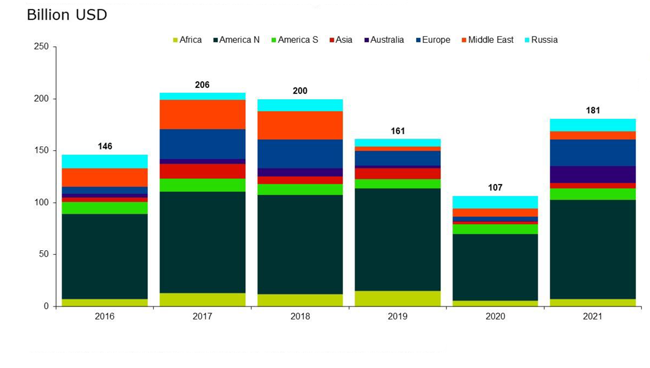
2021 M&A Deal Value Surged to Three-Year High
HOUSTON–Driven by deal making in North America, global upstream merger and acquisition deals rebounded to pre-pandemic levels in 2021, according to Rystad Energy. Total M&A deal value reached $181 billion, up 70% over 2020 and the highest in three years.
Buyers and sellers came together last year as commodity prices gained strength and the market steadily recovered. Deals valued at more than $1 billion accounted for $126 billion, or 70%, of the global total, Rystad says. The share of deals greater than $1 billion rose almost threefold, with 35 deals announced in 2021 compared with just 13 in 2020.
Of the deals values at more than $1 billion, 13 were company acquisitions ($65 billion collectively). Two large Australia-focused mergers–one between Santos and Oil Search and another between Woodside Petroleum and BHP–contributed $22 billion, while other mega deals were focused on North American assets.
The share of resources sold in deals shifted in 2021, with gas accounting for 56% of all traded resources, a sizeable jump from the 43% share it had in 2020. Oil accounted for 31%, and natural gas liquids came in at 9%. Rystad notes that this shift was primarily driven by North American acquisitions, but was helped by deal activity in other regions.
Citing a strong potential deal pipeline, pressure on companies to deliver profitable production, and higher forecast oil prices, Ilka Haarmann, a senior analyst at Rystad Energy, says the upstream M&A market is likely to stay active for the foreseeable future. “The deal pipeline is robust, and the upstream M&A market looks set to continue to strengthen, with deals in the United States likely to remain a crucial driver of the global deal value,” Haarmann states.
Even with a cautious start to 2021, the $181 billion spent on M&A deals increased to levels near the highs of 2017 and 2018, when total deal values reached $205 billion and $199 billion, respectively (Figure 1).
FIGURE 1
Annual Upstream M&A Deal Value by Region
Source: Rystad Energy Upstream M&A Solution, Rystad Energy research and analysis
Portfolio Diversity
Company acquisitions totaled $76 billion, or 42% of the global announced deal value. The largest company acquisition by deal value was the merger of Cimarex Energy and Cabot Oil & Gas to create Coterra Energy, valued at $17 billion. Following suit with most other North American acquisitions announced in 2021, the deal agreement was signed in the first half of the year. Contrasting with the trend in recent years toward pure-play portfolios, Rystad points out that Cimarex oil and Cabot did not have overlapping asset positions. Coterra Energy combines the Permian-focused oil assets of Cimarex with the Marcellus-concentrated gas assets of Cabot.
Geographic diversity also applied for Appalachia-focused independent Southwestern Energy when it acquired Haynesville-focused Indigo Natural Resources for $2.7 billion, and when Paloma Partners acquired Goodrich Petroleum for $480 million. Other U.S. company acquisitions mostly consolidated the buyers’ existing portfolio positions in core operating basins.
The largest field acquisitions were Aker BP’s agreement to acquire Lundin Energy’s oil and gas portfolio, valued at $14 billion, and ConocoPhillips’ acquisition of Shell’s Permian Basin position for $9.5 billion. According to Rystad, field acquisitions in the Permian totaled $19 billion, accounting for more than half of North American field and license acquisitions in 2021, which totaled $35 billion. Russian acquisitions amounted to $12 billion, while European deals clocked in at $24 billion.
The only peer group with positive net inorganic resource growth in 2021 was public companies, while private players and national oil companies divested more resources than they acquired on a net basis. Public companies increased their net resources by 12 billion barrels of oil equivalent through acquisitions last year, Rystad says.
However, there are significant discrepancies between different company segments within this group, the report specifies. The top segment in terms of acquiring resources was public independents growing their positions mainly in North America. Among them were Coterra Energy, Southwestern Energy, EQT Corp., Chesapeake Energy and ConocoPhillips. In total, public independents acquired 34 billion boe of resources in 2021 and sold 21 billion boe, resulting in a net resource growth of 13 billion boe for public independents.
Among public companies, Rystad says majors were the most aggressive in divesting resources in 2021, reducing their collective resources by 5.5 billion boe on a net basis. The largest inorganic resource reduction among majors was made by Shell, which divested nearly 3 billion boe in North America, 500 million boe in Africa, and 200 million boe in Asia. In total Rystad estimates that Shell sold 3.3 billion boe net for more than $11 billion in net proceeds. ExxonMobil–the major with the second-largest inorganic resource reduction in 2021–divested net resources of nearly 1 billion boe for a net amount of about $3.8 billion, mainly through sales in Europe and Asia.
Public independents spent more than 75% of the segment’s acquisition costs on acquiring assets from other public players, including majors. Public companies acquired assets worth $125 billion and sold assets for $114 billion, Rystad reports. In total, private companies acquired assets for $45 billion and sold assets for $46 billion.
Increased Spending
After the increased levels of M&A activity in 2021, research from Rystad forecasts shows an 18% surge in global shale investments in 2022, jumping to $102 billion from $86 billion in 2021. Meantime, offshore investments are set to increase 7% to $155 billion, while conventional onshore will jump 8% to $290 billion.
Overall, global upstream oil investments are projected to rise 7% from $287 billion to $307 billion this year, while upstream gas and liquified natural gas investments are expected to grow by 14% to $149 billion, Rystad projects.
Sanctioning activity is set to rebound in North America, with more than $40 billion worth of projects due for sanctioning in 2022. Six LNG projects are expected to receive the green light, according to Rystad. That total includes five projects in the United States and one in Canada.
Offshore projects also will provide ample opportunities for contractors as TotalEnergies’ North Platte project enters the final stage of its tender process and LLOG Exploration’s Leon and Chevron’s Ballymore developments in the Gulf of Mexico look to proceed to the development phase in 2022, the report adds.
“Despite the ongoing disruptions caused by Covid-19, the outlook for the global oil and gas market is promising,” says Audun Martinsen, head of energy service research at Rystad Energy.
For other great articles about exploration, drilling, completions and production, subscribe to The American Oil & Gas Reporter and bookmark www.aogr.com.







